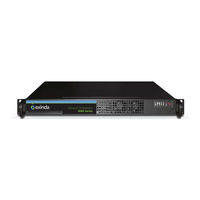Exinda EXNV-4062 Manuals
Manuals and User Guides for Exinda EXNV-4062. We have 2 Exinda EXNV-4062 manuals available for free PDF download: Administration Manual
Exinda EXNV-4062 Administration Manual (751 pages)
Network Orchestrator
Brand: Exinda
|
Category: Network Hardware
|
Size: 23 MB
Table of Contents
-
-
-
-
Scenario75
-
Use Case75
-
Scenario77
-
Use-Case77
-
Use Cases78
-
Related Topics102
-
Related Topics108
-
Related Topics109
-
Related Topics116
-
Related Topics121
-
Related Topics122
-
Related Topics124
-
Related Topics126
-
Related Topics134
-
Related Topics135
-
-
Best Practices147
-
3 Using
172-
-
Before You Begin230
-
-
Dashboards232
-
-
-
Bandwidth Usage326
-
-
-
Logging out454
-
-
Tools465
-
-
4 Settings
481-
Network Settings481
-
System Setup547
-
Certificates587
-
Authentication644
-
Aaa645
-
System Tools653
-
Ping653
-
Traceroute654
-
DNS Lookup654
-
Iperf Client656
-
Iperf Server657
-
-
-
-
7 Copyright
689 -
-
EMC Notice699
-
Compliances699
-
FCC Class a699
-
-
Advertisement
Exinda EXNV-4062 Administration Manual (623 pages)
Network Orchestrator
Brand: Exinda
|
Category: Network Router
|
Size: 21 MB
Table of Contents
-
-
-
Best Practices107
-
3 Using
131-
-
Before You Begin184
-
-
Dashboards186
-
-
-
-
Circuits274
-
Virtual Circuits279
-
-
4 Settings
365-
Network Settings365
-
System Setup426
-
Certificates462
-
Authentication517
-
Aaa518
-
System Tools526
-
Ping526
-
Traceroute526
-
DNS Lookup527
-
Iperf Client528
-
Iperf Server529
-
-
-
-
Diagnostics532
-
Log Files544
-
-
-
7 Copyright
561 -
-
EMC Notice571
-
Compliances571
-
FCC Class a571
-
-
Advertisement

